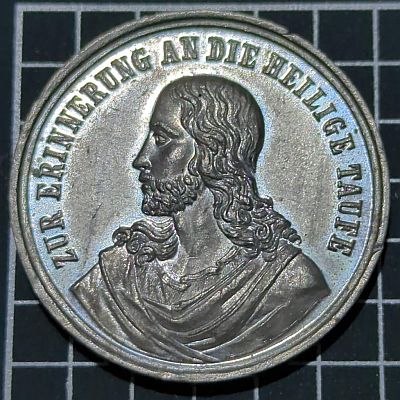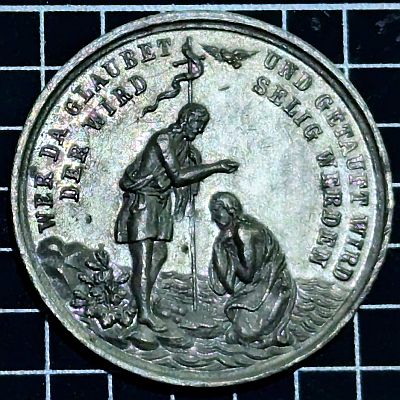A beautiful old pewter medallion
Heads or tails?
Some coins and medallions have a clear obverse and reverse. On some it is harder to define. The US Mint, I think only partly helpfully, explains: “Obverse (heads) is the front of the coin and the reverse (tails) is the back”. Ok, so if it has a portrait on one side, that’s heads – this works for many coins from Commonwealth nations where the side with the monarch is “heads” or “obverse”. This Numista conversation struggles to identify it. It does, however link to Wikipedia, which states: “Generally, the side of a coin with the larger-scale image will be called the obverse (especially if the image is a single head) and, if that does not serve to distinguish them, the side that is more typical of a wide range of coins from that location will be called the obverse.” That seems to work for the Commonwealth coins I mentioned, like this New Zealand 5c, this UK £2, or even this Imitation Spade Guinea. It also works for this Hungarian coin or this Cuban coin where the coat of arms is on the obverse. Euro coins are a little trickier – they have a “Common Side” (across all Euro coins) and a “National side” (designed by each country for each denomination). Based on the above, the “Common side” might seem to fit the definition. But sites such as Numista and NGC put the country’s side as the obverse. Meanwhile, all that was a curious distraction to say, I’m not 100% sure which side the obverse of today’s medallion is! I’m going to go with the side with the larger image, based on the above definition.
Obverse

The medallion features a representation of Jesus, facing left, with the text “ZUR ERINNERUNG AN DIE HELLIGE TAUFE”. This translated to: “In remembrance of the Holy Baptism”.
For Christians, Baptism is the first of seven sacraments they may receive throughout their life. The word baptism comes from a Greek word (baptize), which means, “to immerse.” Baptism is a ceremony in which a Christian is immersed in water before the church to publicly symbolize their belief in Christ. The water is a symbol of sin being washed away. The immersion in the water is a symbol of being brought from death into new life by faith in Christ. The fact that Christians throughout history have practiced this rite of passage, symbolizes that the one baptized is now joined to the church. Baptism is really a powerful symbol of great theological significance.
Baptism was a particularly important rite for Jews prior to the time of Christ. In Matthew 3:11, Jewish prophet John the Baptist said, “I baptize you with water for repentance. But after me comes one who is more powerful than I, whose sandals I am not worthy to carry. He will baptize you with the Holy Spirit and fire.” When Jesus was baptised by him (Matthew 3:13-17), “he saw the Spirit of God descending like a dove and alighting on him. And a voice from heaven said, “This is my Son, whom I love; with him I am well pleased.”
Customary practice when Jesus was baptised was for an adult to be fully immersed in water, often a river such as the Jordan. In modern times, priests often baptise babies by anointing their head with holy water rather than fully immersing them. Some churches still practice full immersion, but the importance is the belief, the symbolism, and the new life, rather than the specific actions in the ceremony.
Reverse

The reverse contains an image of someone being baptised, with the text “WER DA GLAUBET UND GETAUFT WIRD DER WIRD SELIG WERDEN”. This translates as: “Whoever believes and is baptized will be saved”.
This is a direct quote from the Gospels as well. Here from Mark 16:15-18, after Jesus has been crucified, resurrected, and appeared to people. He appears to the Eleven remaining disciples while they are eating and says to them, “Go into all the world and preach the gospel to every creature. Whoever believes and is baptized will be saved, but whoever does not believe will be condemned. And these signs will accompany those who believe: In My name they will drive out demons; they will speak in new tongues; they will pick up snakes with their hands, and if they drink any deadly poison, it will not harm them; they will lay their hands on the sick, and they will be made well.”
I wasn’t sure whether to include the second part of that, but I thought it was a good opportunity for me to learn about it as well. BibleRef.com notes that this is literal, but also not something we should commonly expect. In Acts 2:1-13, the Holy Spirit descends upon the apostles, and they speak in tongues. In response to this miraculous act, foreigners all hear their native language being spoken by these apostles. This is not the gibberish that some call the “gift of tongues.” It is real languages that the speakers honestly don’t know.
While we don’t expect miracles in our everyday lives, a medallion such as this is a reminder to be open to Jesus and to live the life He wants for us.
Pewter
This medallion is made of Pewter. Pewter is an alloy composed primarily of tin with varying quantities of hardening agents such as antimony, bismuth, copper, and lead. It was used in the ancient world by the Egyptians, Romans and other civilisations and came into extensive use in Europe in mediaeval times. Tin was alloyed with copper and bismuth and the resulting metal, although now much harder than pure tin, still possessed a low enough melting point to make it easy for casting.
Although I haven’t found a specific reference for this piece. I have found multiple similar pieces listed online, some in silver. One such piece notes, “Design and iconography points to Philip
Heinrich Muller of Augsburg but this is not possible”. Philipp Heinrich Muller was a German sculptor / medallist who lived from 1657 – 1718, long before these pieces are believed to have been made. Numista lists numerous pieces attributed to him. Perhaps some of his designs lived on, either directly, or in the style of those who followed him.


Leave a Reply